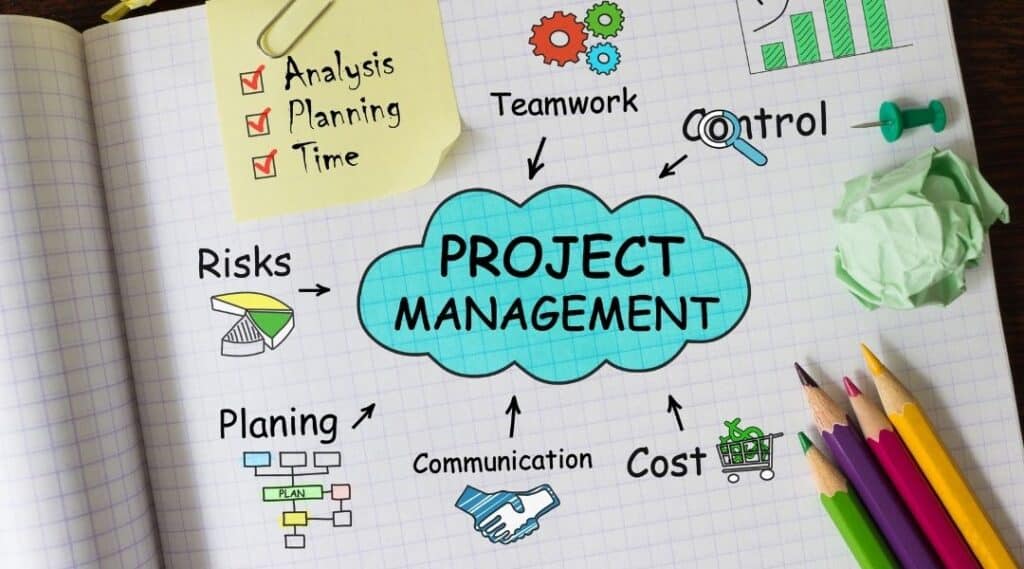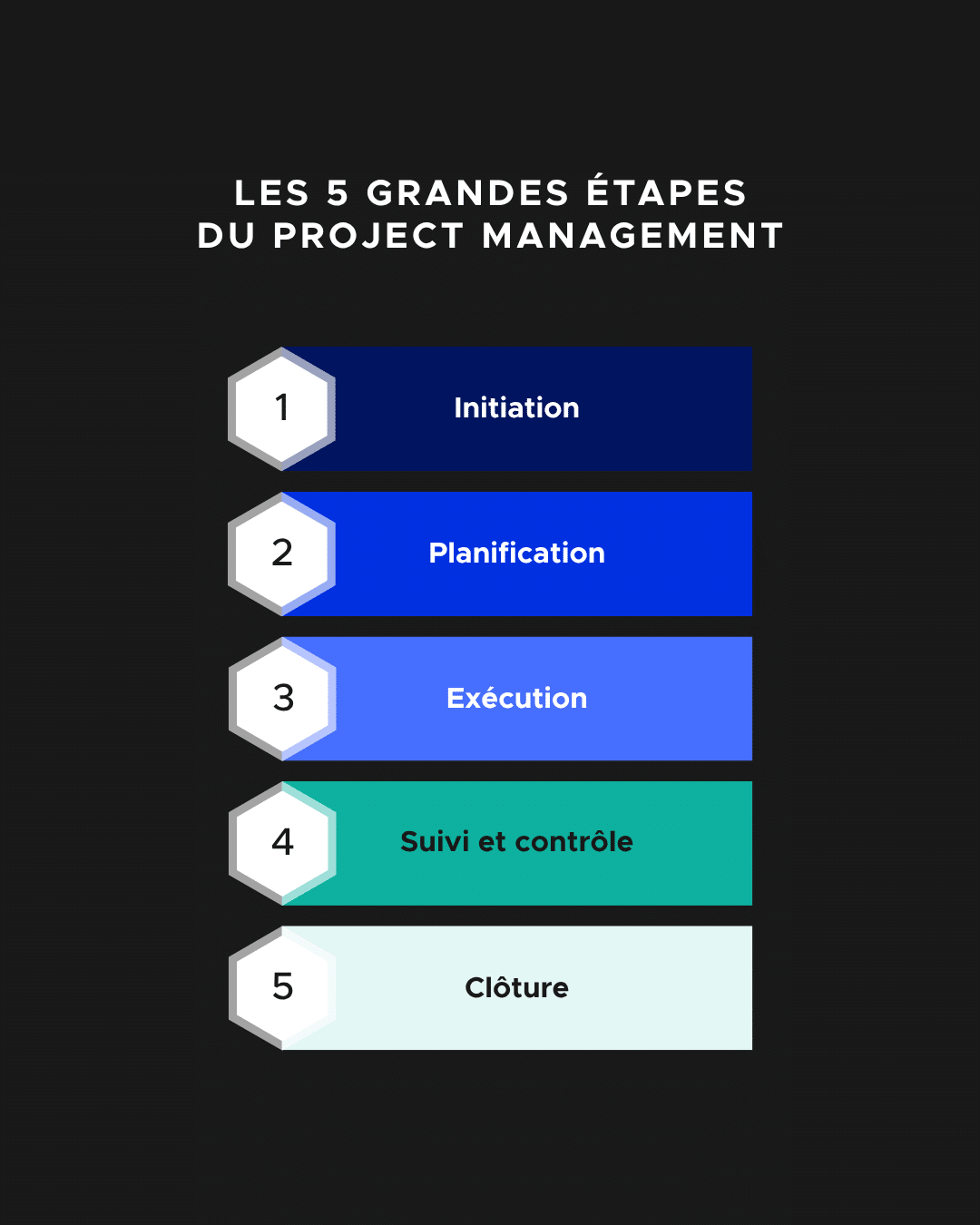In a context where projects are multiplying and becoming ever more complex, project management is establishing itself as a structuring framework for transforming an idea into a concrete result. It makes it possible to clearly define objectives, mobilize the right skills and manage resources throughout the project lifecycle.
But what does project management really mean?
- What are the key stages, from initial strategic decisions to closing?
- Which methods to choose: traditional, agile or hybrid?
- What tools and certifications guarantee effective, recognized management?
This comprehensive guide answers these questions and highlights the opportunities available to project managers at Qim info.
What is project management?
Project management involves mobilizing human, technical and financial resources to achieve a specific objective within a defined timeframe. Each project is structured in phases, planned with a start and end date. Depending on constraints, certain stages may follow one another, while others may overlap to meet deadlines. In concrete terms, managing a project involves :
- define objectives and success indicators,
- mobilize the right skills at the right time,
- effectively manage costs, deadlines and risks,
- ensure consistency between the initial strategy and the results delivered.
The project manager plays a central role in this dynamic: he/she acts as a facilitator, structures the project into clear tasks, coordinates the stakeholders, secures and frames decisions, and ensures the quality of deliverables.

The 5 main phases of project management
Initiation
This phase consists of clarifying the project’s raison d’être: why it is being launched, what benefits it should bring to the organization, and what strategic issues it should cover. It includes identifying stakeholders and verifying feasibility. The strategic objectives, estimated costs, expected benefits and main risks are then recorded in a charter or business case. All too often neglected, this stage is crucial to success: a clear framework avoids ambiguities and ensures that all players share the same vision.
To frame your project effectively, it’s a good idea to formalize your needs in a set of specifications, a document that clearly defines the project’s objectives and expectations. Read our dedicated article here.
Planning
Once the goal has been confirmed, planning transforms this vision into a concrete plan. It is based on four pillars:
- Operational objectives, to specify expected results.
- Structured schedule with milestones.
- Defined resources, in terms of means and responsibilities.
- Risk analysis, to anticipate difficulties and draw up mitigation plans.
This stage also incorporates essential governance tools. The RACI matrix provides a clear division of roles: who is Responsible, who is Accountable, who is Consulted and who is Informed. It ensures a shared understanding of responsibilities and avoids grey areas in project governance.
The risk analysis is formalized in a dedicated register, a living document that lists each identified risk, its probability, impact and associated mitigation plans. Updated throughout the project, it serves as a reference for anticipating and limiting unforeseen events.
Finally, the planning process includes the definition of performance indicators, and concludes with a kick-off meeting at which the roadmap is collectively validated.
Execution
Execution is the phase when the vision becomes reality and the deliverables take shape. The project manager coordinates teams, allocates tasks and ensures that the necessary resources are available. He must also arbitrate between priorities, clarify grey areas and communicate regularly to maintain the cohesion and alignment of all players. Collaborative tools such as Asana, Jira or Trello provide transparency and real-time monitoring. Success depends on:
- optimal resource management,
- precise management using KPIs and dashboards,
- constant flexibility to adjust the plan in the event of unforeseen circumstances.
In agile approaches, execution is based on the product backlog, which centralizes and prioritizes the functionalities to be developed. Regularly refined with stakeholders, it enables efforts to be concentrated on deliverables with the highest added value.
Monitoring and control
This phase ensures that the project is progressing according to expectations, while optimizing the use of resources. Key KPIs include on-time performance, budget utilization, task progress and return on investment.
To ensure effective management, project managers rely on:
- dynamic Power BI dashboards,
- Gantt charts for planning,
- Kanbans to visualize flows.
Key practices include regular alignment meetings, schedule updates and reallocation of resources where necessary. This monitoring process remains evolutionary: it enables obstacles to be anticipated and the trajectory to be adapted. The risk register plays a central role here, as it is updated as progress is made to adjust mitigation strategies and maintain proactive governance in the face of unforeseen circumstances.
Fence
Closing confirms the delivery of expected results and marks the end of the project. It provides an opportunity to capitalize on experience and improve future practices. Major actions include :
- a collective assessment to analyze successes and difficulties,
- KPI evaluation and feedback,
- thearchiving of essentialdocuments, ensuring the transmission of knowledge and the continuity of future projects,
- setting up an improvement plan for future projects.

The main project management methods
A project management method provides a framework of practices, techniques and rules to guide project managers in the conduct of their assignments. It provides answers to simple but crucial questions: what to do, when, how and why.
There are three main approaches:
Traditional methods
These methods are based on a sequential logic: each phase must be completed before moving on to the next. They are well suited to projects where requirements are clearly defined from the outset.
The best-known models include:
- Waterfall offers a linear workflow, from analysis to delivery. It ensures high visibility, but remains costly to adjust if changes occur. It is ideal for regulatory projects where specifications cannot evolve, such as RGPD compliance.
- V-cycle introduces reinforced control: each design stage has its own test phase, which limits errors detected too late.
- Prince2® structures projects around processes and themes such as quality, planning and risk management. It is widely used in IT and complex projects.
Traditional methods guarantee a high degree of visibility on costs, deadlines and deliverables. On the other hand, their rigidity can be a limitation in contexts where requirements change rapidly, or where the scope of the project remains uncertain.
Agile methods
Designed for greater flexibility, agile methods rely oncontinuous adaptation, collaboration with stakeholders and short development cycles, favoring rapid enhancement and improved user satisfaction.
- Scrum organizes work into sprints lasting a few weeks, with defined roles (Product Owner, Scrum Master, team) and follow-up rituals.
- Kanban is based on a visual chart that smoothes production and highlights bottlenecks.
- Lean aims to maximize value by eliminating waste, imbalances and overload.
- Scrumban combines the structured planning of Scrum with the flexibility of Kanban.
These approaches emphasize communication and responsiveness. Today, they are essential in software development and digital transformation projects.
Hybrid methods and new approaches
Many organizations opt for a hybrid model, combining the structure of traditional methods with the flexibility of agile methods. This approach enables sequential logic to be applied to regulated phases, while retaining an iterative approach to design or development.
New practices are also enriching this landscape:
- Design Thinking, which puts innovation and the user experience at the center.
- DevOps, which brings development and operations teams closer together to accelerate deployments and improve quality.
- Scaled Agile (SAFe, LeSS, Disciplined Agile Delivery), which adapts agile principles to the scale of an organization to ensure coherence between several teams and align projects with strategic objectives.
- Value-driven delivery, which emphasizes the creation of measurable value for the company and its users, rather than just the delivery of deliverables.
These developments reflect a fundamental trend: project management is becoming a flexible system, where each organization composes its own approach according to its challenges and internal culture.
Essential project management tools
Digital tools play a central role in the success of modern projects. They help structure tasks, facilitate collaboration and provide a clear view of progress. Their diversity reflects the different levels of project complexity: from simple task tracking to multi-project portfolio management.
Microsoft Project
Microsoft Project is one of the most comprehensive tools for organizing and managing projects. Designed for both planning and collaboration, it offers a global view of progress thanks to its timeline system.
Key features:
- Methodological versatility: waterfall, agile (Scrum, Kanban) or hybrid management, depending on the working method chosen by the team.
- Advanced planning: create precise schedules, estimate task durations and resource requirements using dynamic planning.
- Integrated collaboration: real-time interaction between teams, with native integration with Microsoft Teams to share files and centralize exchanges.
- Detailed monitoring: management of inter-task dependencies, resource allocation, cost analysis and mid-project adjustments.
- Security and reliability: hosted on Azure, the Microsoft cloud, guaranteeing a high level of data protection.
Microsoft Project is aimed above all at organizations wishing to centralize project management in a single tool, capable of adapting to both simple projects and complex programs involving several teams.
Trello, Asana, Jira, Confluence, Notion, Azure DevOps
Collaborative solutions have revolutionized project management thanks to their accessibility and flexibility.
- Trello is based on a logic of tables and cards, which is easy to understand and deploy. It’s ideal for small teams or one-off projects where visibility of ongoing tasks is essential.
- Asana goes a step further with workflow management, dependencies and the ability to automate certain steps. It’s perfect for multidisciplinary teams and projects where coordination is essential.
- Jira, a must-have in agile environments, facilitates sprint tracking, backlog management and task prioritization. Used in conjunction with Confluence, it enables decisions to be documented, reports to be shared and information to be centralized, reinforcing agile, transparent and collaborative management.
- Notion stands out for its versatility: beyond task management, it can be used to create a true team knowledge base. Each workspace can be fully customized, making it just as effective for project tracking as for collaborative documentation.
- Azure DevOps combines agile project management and continuous integration/continuous deployment (CI/CD). It offers a complete environment for planning, developing, testing and delivering applications, while natively integrating DevOps practices and backlog tracking.
These tools are generally adopted for their ease of implementation, intuitive interface and ability to foster real-time collaboration.
To find out more about Asana, Notion or Trello, read our article: The 10 best collaborative tools.
SAP, Oracle and integrated suites
Integrated project management suites are aimed at large organizations wishing to link their project management to other strategic corporate functions: finance, human resources, purchasing or supply chain. Among these, SAP and Oracle dominate the market, each with its own specific features.
- SAP stands out for its modularity and functional depth. Widely used in the industrial and logistics sectors, it enables fine-tuned, customized management of business processes. Its ability to integrate data from multiple departments makes it a benchmark for companies with complex, highly regulated operations.
- Oracle, on the other hand, focuses on analytical power and data exploitation. Its cloud platform (Oracle Cloud ERP) is designed to process large volumes of information and provide real-time analysis. This makes it a preferred choice for organizations seeking responsiveness and an immediate view of performance.
Both solutions offer a centralized view of resources, costs and results, while guaranteeing traceability and compliance. However, their deployment remains a heavy investment, requiring organizational adjustments and extensive team training.
They are particularly useful in the context of strategic, multi-department projects, where integration with the entire information system and data reliability are essential conditions for success.
Comparing tools according to needs
| Category | Tools concerned | Ideal uses | Limits |
| Simple management | Trello, Notion | Visual task tracking, one-off projects or small teams, collaborative documentation. | Limited functionality for complex projects. |
| Advanced management | Asana, Jira, Confluence, Azure DevOps | Multi-disciplinary coordination, agile environments, sprint tracking, backlogs and dependencies. | More demanding implementation, learning curve for Jira. |
| Structured management | Microsoft Project | Detailed planning, resource allocation, complex projects with cost and deadline constraints. | Complexity of the tool, need for training for effective adoption. |
| Integrated suites | SAP, Oracle | Multi-department strategic projects, strong integration with finance, HR and supply chain, compliance and traceability. | Costly, cumbersome deployment, organizational adaptation required. |
PMI, PMP and other project management certifications
In a market where project management is increasingly strategic, certifications play a decisive role. They reinforce the credibility of professionals, testify to a high level of skills and open up access to international career opportunities.
Project Management Institute (PMI)
The PMI is the leading international organization in the field of project management. Founded in 1969, it now brings together over 600,000 members and provides standards that are widely adopted across organizations worldwide.
His main contributions:
- The PMBOK®, a methodological guide that structures project management practices.
- The availability of internationally recognized certifications (PMP, CAPM, PgMP, etc.).
- A worldwide community for sharing and updating best practices.
Project Management Professiona (PMP)
The PMP certification, issued by the PMI, is the most globally recognized project management credential. It demonstrates comprehensive expertise in project management and serves as a powerful catalyst for career advancement.
Key points of PMP certification:
- International scope: recognized in all sectors and on all continents.
- Solid reference system: based on PMBOK®, the industry standard.
- Target audience: experienced project managers with a minimum number of hours of validated practical experience.
- Certified skills: planning, risk management, cost monitoring, stakeholder management.
- Career impact: according to PMI (Earning Power Report, 13ᵉ edition, 2023), PMP certification holders receive on average 33% higher remuneration than non-certified holders.
Other recognized certifications
In addition to the PMP, several certifications are widely recognized and valued in the field of project management. They enable professionals to adapt their expertise to different methods and organizational contexts.
- PRINCE2® (Projects IN Controlled Environments): a widely used methodology, particularly in Europe. Based on a process-based approach, it provides a clear framework for managing complex projects, focusing on governance, risk control and ongoing project justification.
- AgilePM® (Agile Project Management): certification issued by APMG International. It aims to reconcile the flexibility of agile methods with the rigor of project management. Based on the DSDM framework, it provides tools for prioritizing needs, structuring roles and delivering value incrementally.
- CAPM® (Certified Associate in Project Management): offered by PMI, this certification is the first step towards a career in project management. It validates fundamental knowledge and is particularly aimed at recent graduates or professionals undergoing retraining.
- Certified ScrumMaster (SCM): issued by the Scrum Alliance, this certification is designed for agile environments. It validates mastery of the Scrum framework and the ability to support a team in its application. The Certified Scrum Master acts as a facilitator, helping the team to self-organize, removing obstacles and ensuring that agile principles are respected.
Together, these certifications cover a broad spectrum of practices, from sequential and highly governed approaches to agile and collaborative environments. They enable project managers to raise their profile and adapt to the specific needs of organizations.
Why become a project manager at Qim info?
Joining Qim info as a project manager means joining a fast-growing company, recognized for the quality of its digital services and its solid roots in Switzerland and France. With over 600 employees and expertise covering a wide range of sectors, Qim info offers project managers a stimulating environment where they can put their know-how into practice and develop through contact with a variety of assignments.
The project manager’s scope of action
At Qim info, project managers support customers in the success of their strategic projects, ensuring that teams are well coordinated and objectives are met. Their missions cover several areas:
- IT and software development: management of application design and deployment projects, often using agile methods.
- Infrastructure and cloud: support in modernizing systems, migrating to the cloud and securing environments.
- Digital transformation: management of initiatives to optimize business processes, improve user experience and introduce new technologies.
- Various sectors: banking, insurance, healthcare, industry, public services, where project management needs are strategic and require adapted skills.
Working closely with consulting teams and customers, the project manager at Qim info becomes a key player in the success of projects, while also having the opportunity to develop sectoral or methodological expertise (agile, hybrid, traditional).
To find out more about the job of IT project manager, see our article: Job description: IT project manager.
Salary and career development
At Qim info in Switzerland, a project manager’s career evolves according to the skills developed and experience gained with customers. With offices in Geneva (Carouge and Petit-Lancy), Lausanne, Zurich and Basel, the company actively encourages its employees to take part in training courses leading to certification, and offers them the means to progress in their professional development.
In Switzerland, the salary of an IT project manager depends on several factors: the level of experience, the location of the position, the specialized skills required and the type of company employing the manager.
Career development can lead to program manager positions, where the supervision of several projects becomes central, or to a delivery manager role, guaranteeing the quality and performance of delivered projects. Some consultants also choose to join the Project Management Office (PMO ) to define and steer project management methodologies. With experience, project managers can also progress to management positions, such as department manager or program director, opening the way to a rich and varied career within ESN.
Consult our job offers here and join Qim info.




